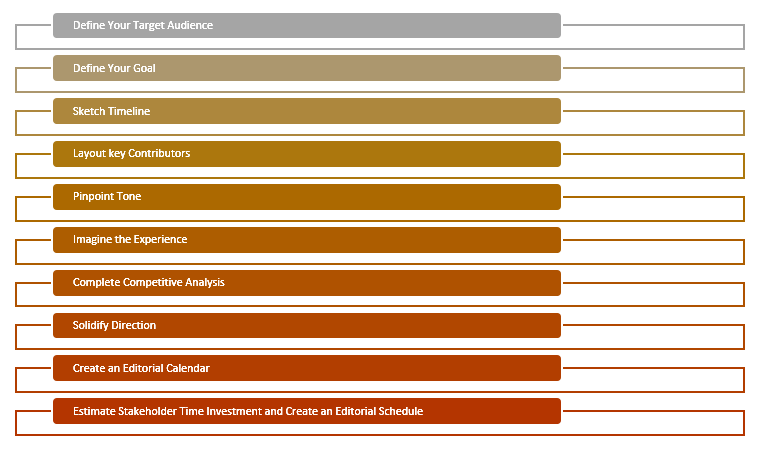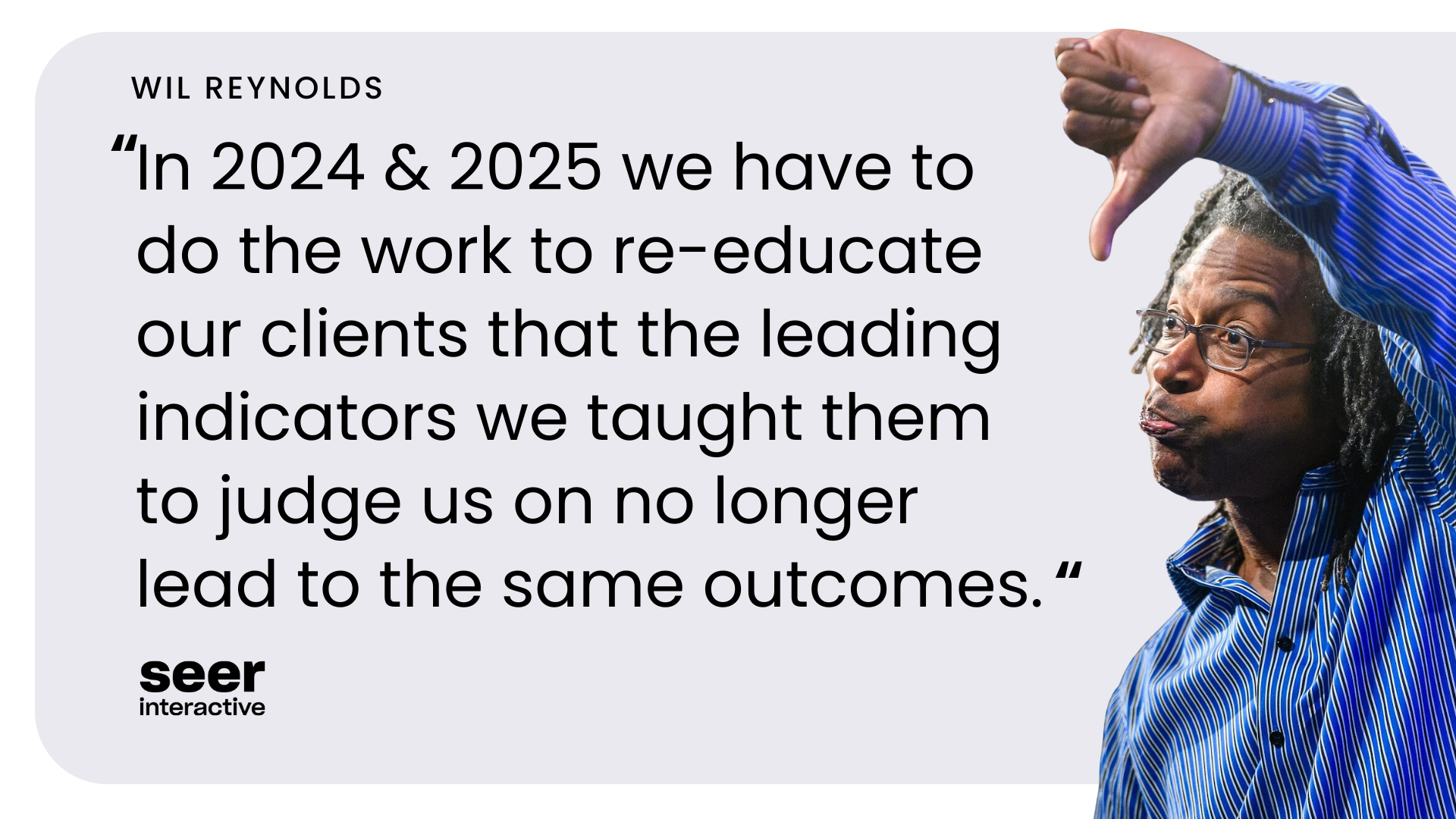True leaders recognize the value they have to offer. They listen to those around them and are consistent in their teaching. They share personal stories that others can relate to, and offer tools and information to help strengthen the community. Blogs can be leaders in the same way, should the right contributors be committed to engaging and educating the target community via the channel.
But launching a blog can be tough. There are a lot of moving parts, and knowing where to start and getting off the ground can be intimidating. I’ve gone through the process a few times before, and found the following checkpoints to be immensely helpful.
I hope the list, broken down for you in this post, serves as a guide for you as your blog comes to life. If you have questions, or ideas for improvement, please join the conversation in the comments section at the end of the post.
Okay, here we go. And this should be exciting! Like naming a puppy.

Checkpoint 1 – Define your target audience
In my experience, it is really helpful to identify the audience you are speaking to. If you understand who you are talking to, and what they are interested in, you are significantly more likely to create content that will get the traction you deserve. You’ll be creating something for an audience, versus creating something and then trying to sell it to an audience. The former has proven to be a lot easier time and time again.
Checkpoint 2 – Define Your Goal
It is okay to have a more than one goal, but the more clearly you can define a primary goal, the easier it will be for you to execute a great strategy and create a reporting strategy that will get key players on board with what you are doing. Here is a list of some common goals. You will notice that some of these goals are more immediately ROI driven, while others are driven by long term visibility and sustainable community engagement (h/t Brian Jensen for collaborating with me to put this list together). Align the goal for your blog with the larger goals your organization is striving for and you are bound to succeed.
- Build community
- Drive referral traffic and sales on yourwebsite.com
- Raise awareness
- Build an email list via blog subscriptions
- Establish thought leadership
Checkpoint 3 – Sketch Timeline
I imagine that plenty of us digital communication folks have come to dread the word ‘timeline.’ When you are doing things that are groundbreaking, often times there are a lot of chefs in the kitchen and unforeseen roadblocks and opportunities. The result? Your timeline in shambles. I challenge you to sketch it out anyway! Your timeline will help ensure that your blog actually makes it off of the ground by keeping the process moving.
Here are some important milestones to consider:
- Creative development
- Technical development
- Creative reviews and technical adjustments
- Content formats
- Initial content creation
- Influencer discovery for promotion
Rationalize your timeline by working around a major company milestone, the launch date of a big campaign, or a seasonal trend.
Checkpoint 4 – Lay out Key Contributors
The success of your blog is seriously contingent upon your contributors. The purpose of your blog should be defined by the collective knowledge of your contributors. If your purpose is aligned with the expertise of your writers, they will feel comfortable contributing the blog. More importantly, the content will likely be more valuable for your users. The idea is simple. If you want to bake a cake (because you love cake), but you only have 2 cans of blueberry filling and a pie crust, you might want to consider making a blueberry pie.
Gather the writers you wish to contribute and outline their areas of expertise. Send them a survey to gauge their interest in participating and ask them what they are interested in writing about. Once you have your data, try to pinpoint common themes and highlight areas where you see consistency.
Checkpoint 5 – Pinpoint Tone
A voice and tone guidelines sheet can be really useful for facilitating a shared communication style. This guide should help ensure that the experience users have on your blog is consistent. The tone guidelines should be considered when writing content, responding to comments, and performing outreach to promote content.
The tone of your blog may be inspired by your writer’s personalities or the culture of your organization. Your blog will seem more genuine if your tone is organic. I really like this example from Gather Content:
Write like this: “This is great, Mike! Really practical suggestions for approaching complex issues with kids. We’ll be sure to pass this along to Krista.”
Not like this: “Your response has been noted and will be responded to within 2-3 business days.”
Why: Demonstrating an open, responsive attitude towards your thriving community shows respect for your users, and embodies the values you are trying to teach through your site’s content.
Checkpoint 6 – Imagine the Experience
Your blog should have an experience, just like a restaurant or store. Think about the experience when you walk into your favorite restaurant. Think about the personas of the staff, the décor. Are the walls made of wood to compliment the rustic menu and endless bourbon list? Is the staff laid back or are they buttoned up? All of these details make the experience what it is.
Chances are you will have several players working to make your blog come to life. Describing the experience you are going for to designers, developers, and contributors will help everyone bring your vision to life.
Checkpoint 7 – Complete Competitive Analysis
In the digital world, competition and opportunity is everywhere. Create a plan to scour the landscape and see what is out there. Discover influencers and what they are writing about. You may also think about partnering with them or hiring them down the line. (Pro Tip: LinkedIn Pulse is a great way to see what type of content is gaining traction and to identify influencers. Especially if you’re in the B2B space).
You might come across an article, video, or content series that you can reformat or build upon on. Note these things, and bake them into your strategy. Are there unchartered waters in terms of content formats? Take advantage of that. Take a look at the websites that resonate with your audience and gain an understanding of the content that gets the most social shares, links, and views. Open Site Explorer can be very useful for doing this. You can also analyze forums and gain a better understanding of your audience’s pain points, topics of interest, and ways people communicate and share with each other.
Checkpoint 8 – Solidify Direction
Have fun fleshing out the ways in which the content on your blog is going to support your readers. You should have your audience at this stage. So dig in and figure out why your blog will be appealing to them.
I like to use the old 5 W’s for this part as it really helps hit the direction from all angles.
- Who do we want to teach?
- What news or information do we want to provide?
- When should we engage in conversation?
- Where can we join the community?
- Why are we different?
Checkpoint 9 – Create an Editorial Calendar
Your editorial calendar doesn’t need to have topics filled in for a year. If you have a few months of content slated for creation on a regular basis, you’re in a good place to launch. There is actually a benefit to sort of going with your initial insights and gut for the first few months and then looking at the data and re-evaluating your content strategy based on what is working.
In order to increase your chances of organic exposure, you can use tools like Google Trends to help you understand what is popular at which times of year, and tools like Google Keyword Planner to help you identify popular keywords and queries that you can incorporate into the titles and content within your posts.
Checkpoint 10 – Estimate Stakeholder Time Investment and Create an Editorial Schedule
Be transparent with writers in terms of how much time investment you estimate needing from them. Get their feedback, and plan accordingly so that those writers with less time are writing less often, and so on.
It has proven helpful to create a schedule for your writers and editors. Your schedule could be as simple as:
- First Friday of the month, writers finalize their topics and sign off that they will be writing the post
- Posts should be delivered 2 weeks after they are assigned
- Editors have one week to review posts (Pro Tip: Create and provide the same rubric to writers and editors so that everyone knows how the writing will be evaluated during the review process.)
- Writers have one week to make changes and approve editorial recommendations
It is important to note that this is not a one size fits all process. The critical takeaway is to give everyone enough time, and plan, plan, plan.
That just about wraps it up. I hope you find this checklist to be of use as you launch your corporate blog. Good luck, and have fun. Again, please share your experience and recommendations in the comments below.
Follow me on Twitter @afreezee

